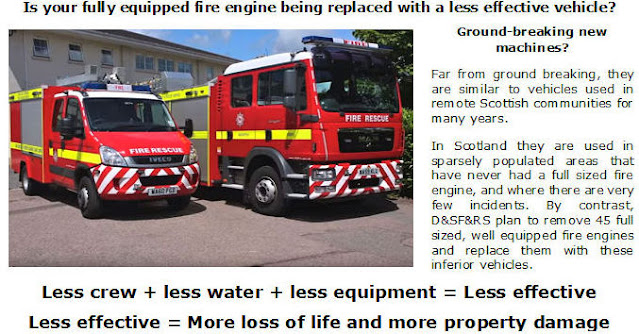Council tax consultation
There are 26% fewer immediate response firefighters protecting
Devon & Somerset residents than there were ten years ago.
Before I look at Devon and Somerset Fire and Rescue Service's deception, I just wanted to remind people that there is a consultation running on the amount of council tax people pay towards the service (Consultation link).
The consultation ends on the 18th December.
Unfortunately, as Government has continued to cut funding, despite expecting the service to take on more and more work, only a council tax increase will avoid further cuts to the service.
I would encourage people to carefully consider their answers to questions like, "How satisfied or dissatisfied are you with the service provided by Devon and Somerset Fire and Rescue Service" and "Thinking about your local fire and rescue service, do you think they have a good reputation".
You may be very satisfied with your local firefighters, but less so with the service's senior management and the Fire Authority. You can be sure that both senior management and the Fire Authority will claim the credit for positive answers, even though you may be thinking of those at the sharp end when you answer.
If that is the case, I would suggest selecting an answer that reflects your view of those at the top, and clarify in the "What has influenced your answer?" box that you are satisfied with firefighters, control operators and others who actually provide the service to the public.
Who lied and who did they lie to?
Many will remember when DSFRS planned to replace around a third of their fully equipped fire engines with inadequately equipped vans. They called them Rapid Intervention Vehicles (RIV) and told Councillors and the public that their locations would be selected based on the risks in that area.
There then followed a lengthy process of complaints to the Information Commissioner. Last year she confirmed that Devon and Somerset Fire and Rescue Service had breached the Freedom of Information Act and ordered them to provide additional information, including some that had been unlawfully redacted. Some more information was forthcoming, but still no risk assessments.
No assessment of the effect on the service's ability to deal with incidents with less water, less hose and less equipment, and not carrying certain equipment at all on these third rate vehicles.
No assessment of the risks in the station areas they were to be allocated to.
So I went back to the Commissioner and this year, after further correspondence with DSFRS, the Commissioner said that she had accepted the DSFRS claim that there was no other documentation.
So, either DSFRS lied to the Information Commissioner, which is unlikely, or they never carried out the risk assessments that they told Councillors and the public that they had carried out.
Not only no risk assessments, but absolutely no documentation referring to the risk of replacing full sized fire engines with less capable vehicles, and no documentation about RIV locations being determined by the risk in that area. No reports, no memos, no emails, absolutely nothing. Yet despite this fundamental omission, they had placed an order for 15 RIVs, with an option for another 30.
I find it astonishing that a fire & rescue service would embark on such a fundamental change without assessing the impact that would have, yet clearly that is what DSFRS did. Without assessments they had even decided where these vehicles and the supporting Incident Support Vehicles (carrying equipment not available on the RIVs) would be located. The locations were among the details they hid, until ordered by the Commissioner to reveal them, and you can see why.
It reveals the true scale of their inept plans and how seriously reduced protection for residents would be.
They now claim this plan was 'never adopted', but it would be more accurate to say that they have backtracked. The order for the other 30 RIVs is now on hold, hopefully to be abandoned completely. The plan shows very clearly that this was never about matching resources to risk, with RIVs scattered across the two counties at city, town and rural stations with a diverse range of risks.
It is interesting to note that Hampshire Fire & Rescue Service looked at replacing a number of fire engines with very similar RIVs, but sensibly only ordered one to be trialled at a variety of stations. They found it unsuitable and have now abandoned the idea.
Instead, to reduce the current size of their fire engines without sacrificing capability, they have chosen more compact fire engines that are narrower and shorter, but are far better equipped than DSFRS's RIVs. Just 12 centimetres wider, they carry nearly twice as much water and a lot more equipment. They can even turn tighter corners than the RIV's, as their turning circle is just 12.4 metres, whilst the RIV's is 13.7 metres.








